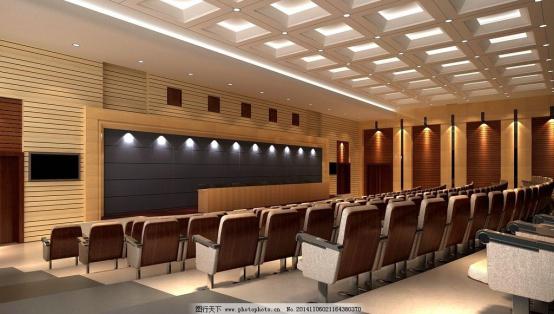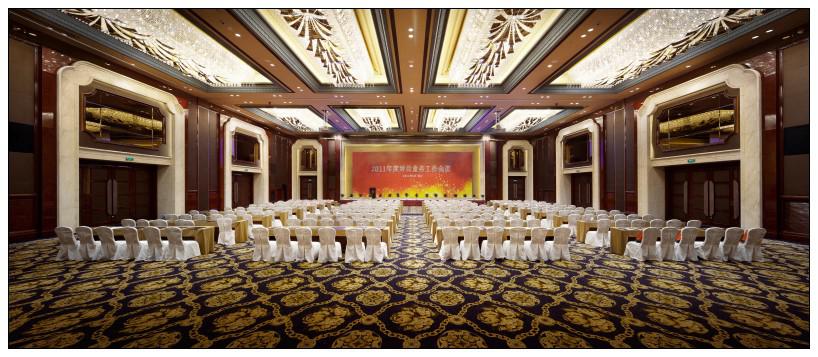I. Building Overview and Application Requirements. The conference halls are mainly used for conferences and reports; small size performances and the projection of movies are also considered. The electroacoustic form is the main form during application.
II. Relevant Building Acoustic Design Codes :
GB50118-2010——Code for sound insulation Design of Civil Buildings
GB/T50356-2005——Code for Architectural Acoustical Design of Theater, Cinema and Multi-use Auditirium
JGJ 57-2016——Theater Building Design Code
GB 50016-2014——Fire Prevention Code for Building Design
GB/T 50076-2013——Reverberation Time Measurement Code for Halls
III. Guideline for Building Acoustic Design for Lecture Halls
The guidelines for the building acoustic design are as follows based on the acoustic requirements of the uses:
1. Reasonable indoor reverberation time design;
2. Sufficient volume and proper voice articulation;
3. Reasonable sound reflection and diffusion design;
4. Uniform sound field distribution without sound quality defects that disturb listening. Based on the above mentioned requirements, the contents of building acoustic design mainly include reverberation time control for the lecture halls and elimination of sound defects.
IV. Building Acoustic Design Indicators in order to ensure articulation and fullness of the voices at the conferences, based on the requirements of uses, design code requirements and the curren form, the best reverberation time for the conference halls is determined to be 1.0+0.1s(500Hz) for the medium frequency, and for low frequency, 20% increase if allowed.
V. Current Status Analysis;
The wall surfaces of the conference halls are treated by perforated sound absorption wood boards and sound absorption soft packets. With proper perforation rate and structural making method, the sound absorption requirements can generally be met. Based on the past experience, though the perforated sound absorption wood boards have good decoration effect, the base material is usually density board, which emits a large amount of formaldehyde after slotting and punching. Especially when in a relatively enclosed environment, the smell is hard to go out, disturbing the participants. Besides, the density boards are prone to deformation in a humid environment and prone to corrosion in the presence of water. Thus it is recommended to use dome waterproof and environmental friendly materials to replace the density boards. During construction, proper structural design shall be made based on the acoustic inspection reports of the selected materials. The cloth wrapped on the surface of the soft packets is advised to undergo fireproof flame retardant treatment. The packing material is preferred to be sound absorption cotton with certain thickness and volume weight, meeting the acoustic requirements.

Diffusion:
Some diffusion materials are recommended to be used on the back wall of the conference halls to enhance the primary reflected sound of the back row audience and to make the sound field in the entire halls more uniform to prevent interference by the back wall reflected sound to the front row audience.
Stage:
The sidewalls and the back wall of the stage also undergo some sound absorption treatment. The ceiling is sound absorption ceiling to meet the requirement of small size performances.
VI. Indoor Noise Control
To create a quiet environment, the noise must be controlled for the conference halls. Without consideration to the entry of the external nose, the indoor noise level shall be controlled below 35dB(A). The indoor noise mainly comes from the air conditioner vents, lighting apparatuses, moving of chairs and operation of the projector. The air conditioner rooms locate at two sides behind the podium. Proper sound isolation measures are recommended for the air conditioner rooms: use high sound isolation walls and doors, and conduct shock absorption treatment to the equipment in the rooms to prevent disturbance to the listening of the leaders at the podium during normal conferences.
The background noise level in the halls affects the voice articulation and listening effect. Usually , at the position of the lowest sound level in the halls, when the signal to noise ratio(S/N) is more than 30dB, there will not be obvious influence on the articulation. If the signal to noise ratio is up to 50dB, high quality sound reproduction can be achieved. The average sound level in the voice electroacoustic system in the halls is generally about 70dB. The background noise is also the dynamic lower limit of the source component of the electroacoustic system, directly affecting the listening effect of the audience. According to international standard noise rating NR curve, this is the parameter for evaluating the noise disturbance and nuisance. The allowed noise value in various halls and specialized halls as well as the indicators used in some halls in china based on the actual noise level and design are usually below NR40. To ensure sufficient signal to noise ratio, on the condition that all the equipment generating noise in the conference halls are running, e.g. Air conditioners and controllable silicon dimming equipment, the background noise with an empty auditorium shall be meet the requirement that the noise rating is NR35 or below. Effective sound and vibration isolation measures shall be taken for the conference halls. The sound and vibration isolation indicators shall be in accordance with Standards of Environmental Noise of Ubran Area(GB 3096-2008): 50dBA in the daytime and 40dBA in the nighttime, with good control on the sound isolation, local noise, sound resonance, sound focusing, sound scattering, sound diffusion and standing wave.

